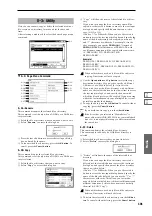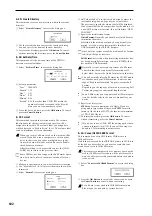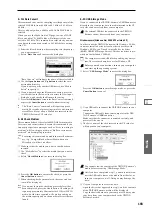
Ef
fect
205
8. Effect Guide
The effects section of the TRITON Extreme consists of five
Insert Effects
, two Master Effects, a stereo, three band Mas-
ter EQ
, and a Mixer section that controls the effect routings.
You can select any of 102 digital Insert Effects or 89 digital
Master Effects, as listed below:
Classification of 102 effects
Select the desired effects 000–089 from IFX 1, 2, 3, 4, and
5, and MFX 1 and 2. Effects 090–102 are double-size
effects and use twice the area, compared to other
effects. They are selected in IFX 2, 3, and 4.
1. Effects in each mode
In Program mode, you can process sounds using Insert
Effects
. This is something like processing an oscillator (OSC)
output sound using a filter and an amplifier. Then, you can
apply a modulation and reverb effect or other Master Effect
to the processed sound to add ambience and space. Finally,
before the sound is output from the OUTPUT (MAIN) L/
MONO, and R connectors, you can fine-tune the tonal qual-
ity using the stereo, three-band Master EQ. You can adjust
these settings for each Program individually.
In Combination mode, Sequencer mode, and Song Play
mode
, you may process Program sounds for each timbre
and track using the Insert Effects, add ambience and space
to the entire sound using the Master Effects, and adjust the
overall tonal quality using the Master EQ.
You can make these settings for each Combination in Com-
bination mode, for each Song in Sequencer mode, and for
the Song Play mode individually. In Sequencer mode you
can switch effects or change effect parameter values while
the song plays back.
In Sampling mode, you can sample while applying insert
effects
to the internal audio input from AUDIO INPUT 1, 2,
or S/P DIF IN jacks. Settings in Sampling mode are made in
Input (SAMPLING)
(Sampling P0: 0–2a). These settings are
valid only for Sampling mode.
You can also sample while applying an insert effect to the
samples assigned to a multisample. (Sampling P0: 0–2b)
The external input from the AUDIO INPUT 1, 2, or S/P DIF
IN
jacks is also valid in modes other than Sampling mode.
In Program, Combination, Sequencer, and Song Play modes,
you can use the insert effects, master effects, and master
EQ
. Settings for external input from the AUDIO INPUT 1, 2,
and S/P DIF IN can be made in “Input (COMBI, PROG,
SEQ, S.PLAY, MEDIA)” (Global P0: 0–3a).
In these modes, the external input sound from each jack can
be processed by the TRITON Extreme’s effects and sampled,
or the TRITON Extreme can be used as a 4-in (AUDIO
INPUT 1, 2, and S/P DIF IN L, R) 6-out effect processor. The
TRITON Extreme can also be used as a vocoder effect (093:
Vocoder
) that uses external mic input to control internal
sounds.
When effects are applied to the external input sound
from the AUDIO INPUT 1, 2, and S/P DIF IN jacks, cer-
tain effect types or parameter settings may cause oscil-
lation to occur. If this occurs, adjust the input level,
output level, or effect parameters. Please be aware of
this particularly when using an effect that has a high
gain.
2. Dynamic modulation
(Dmod)
Dynamic modulation
is a function that enables you to con-
trol and change in real-time certain parameters
*1
of the TRI-
TON Extreme that govern the intensity of the effects during
performance via the TRITON Extreme’s controllers and
incoming MIDI messages.
You can also control the effect parameters using the BPM/MIDI
Sync function
*2
. Using this function enables you to synchronize
the LFO speed of modulation effects or the delay time of delay
effects with the tempo of the arpeggiator or sequencer.
For more information, refer to “Dynamic Modulation Source
(Dmod)” (
*1
These effect parameters are marked with
(
*2
The effect parameters marked with
support this
3. Effect I/O
To achieve the best tonal quality, signals sent to the Master
Effects should be output at the maximum level without clip-
ping. Also, use the “Wet/Dry” parameter for the Insert
Effects and the “Output Level” or “Return 1, 2” parameter
for the Master Effects to adjust the effect output level.
000–015
Filters and dynamics effect, such as EQ and compression
016–031
Pitch modulation and phase modulation effects, such as cho-
rus and phaser
032–040
Other modulation and pitch-shifting effects, such as rotary
speaker and pitch shifter
041–051
Early reflection and delay effects
052–057
Reverb effects
058–089
Mono effects and mono chain effects, in which two mono
effects are internally connected in series
090–102
Double-size effects
Overview
Insert Effect 1-5
Master EQ
Oscillator
Filter
Amplifier
Return
Send
OUTPUT
L/MONO, R
Master Effect 1,2
Master EQ
Return
Send
OUTPUT
L/MONO, R
Timbre 1 / Track 1
Timbre 2 / Track 2
Timbre 8 / Track 16
Insert Effect 1-5
Master Effect 1,2
Insert Effect 1-5
Sample
Recording
Insert Effect 1-5
Resampling
Sample
AUDIO INPUT (1, 2)
S/P DIF IN (L, R)
Insert Effect 1-5
Master EQ
Oscillator
Filter
Amplifier
Return
Send
OUTPUT
L/MONO, R
Master Effect 1,2
AUDIO INPUT (1, 2)
S/P DIF IN (L, R)
Summary of Contents for TRITON Extreme
Page 1: ...2 E ...
Page 11: ...xii ...
Page 111: ...100 9 5 Page Menu Command 0 1A 0 1I 0 1J Program 9 5A ...
Page 185: ...174 ...
Page 215: ...204 ...
Page 281: ...270 ...
Page 349: ...338 ...
Page 350: ...339 ...
Page 351: ...340 ...
Page 352: ...341 ...
Page 353: ...342 ...






























